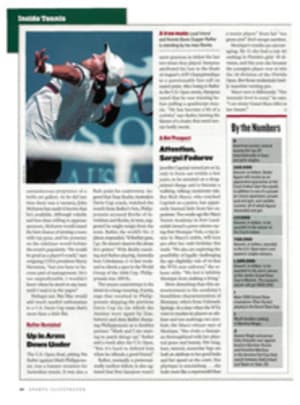
The Offense That Refuses To Die Disciples of the single wing loudly sing its praises and ardently seek converts
Is this football?
Quarterbacks who never take a snap. Fullbacks who do and then
often pirouette 360 degrees with the ball. Tailbacks who must be
able to both run and pass. Quick kicks? O.K. But fake quick
kicks? Quick kicks on first down?
This is a revival meeting. For three days in June, 38 men from
every corner of the country assemble in Manitou Springs, Colo.,
for the second National Single Wing Football Symposium. There
they probe the potential and extol the virtues of an offense so
old that few people under 50 can say they've seen it in action.
But the congregation in Colorado displays the enthusiasm of
Viagra converts. Especially the guy wearing a THE DINOSAUR LIVES
T-shirt. They have come to talk of full-spinner series and buck
laterals. To share success stories. To stand up and be counted.
Bill Jache, San Diego: "My Pop Warner team is 60-4-1 in the last
five years. Last year we won the national championship."
Tim Black, Englewood, Colo.: "Our peewee team went undefeated
last season. In 10 games we attempted eight passes. Seven went
for touchdowns."
Norris Patterson, William Jewell College, Liberty, Mo., retired:
"We were 132-34 in 18 years with the single wing."
Jerry Carle, Colorado College, retired: "46-7-1 in six seasons."
Most of those in attendance are playbook-thumping converts. A
few, such as Carle, Patterson and Marv Wetzel (Trinidad State
Junior College in Colorado, retired), are old enough that they
grew up playing the single wing. One group, the seven-man staff
from Parkview High in Sterling, Va., is contemplating a leap of
faith.
The single wing features four backs--a fullback and tailback,
positioned side-by-side 4 1/2 yards behind center and either
available to take the snap; a quarterback, who lines up directly
behind the strong-side tackle in an unbalanced line; and a
wingback, who lines up on the outside shoulder of the tight end.
There are no wide receivers.
The tailback is the most important player in the single wing
because of his dual role as passer and runner, but the center
also plays a crucial role in the offense. He must be able to
unfailingly snap the ball to either the fullback or tailback
with the dead-eye accuracy of a sniper. Once the ball is
snapped, the tailback typically runs off tackle or around end
escorted by a convoy of linemen and other backs as blockers, but
over the years deception has been added to the formation, which
sometimes finds the four backs moving in a dizzying choreography
of feints, spins and quick cuts designed to befuddle the defense.
The single wing was invented by Pop Warner, who wrote a book on
the formation in 1912 when he was the coach at the Carlisle
(Pa.) Indian School, and was the dominant offense used in high
schools, colleges and the pros until just before World War II.
Knute Rockne and Amos Alonzo Stagg coached it. Jim Thorpe and
George Gipp are two of the better tailbacks who executed it. All
of them winners. All of them legends. All of them dead.
So too, for the most part, is the single wing. It was last
spotted in the NFL in 1951, with the Pittsburgh Steelers. The
last major college team to use it was Princeton, in 1969. When
Denison University coach Keith Piper died in February at age 78,
the single wing expired with him on the college level. Only a
handful of high school and youth level coaches employ it today.
Almost all of them are attending the conference in Colorado.
Carl Rice, coach of Cedaredge (Colo.) High, is the symposium's
first speaker. Cedaredge has lost two games in the 1990s. "We
don't have a Wide Jet 36X Back Cross," Rice says with disdain.
"You know how we call our plays? 'One,' that's a play. We run
'two.' 'Three,' that's another play. We go all the way up to
'nine,' but to tell you the truth we seldom get past 'four.'"
Dan Johnson, the coach at Wichita (Kans.) Southeast High, raises
his hand. "Coach, for blocking assignments do you number your
holes," asks Johnson, "or do you number your offensive linemen?"
Rice smiles. "No."
In the back of the gym, a few members of the Sterling Seven
scratch their heads.
Carle installed the single wing at Colorado College 26 years
ago. From 1957 to '71, Carle's record with multiple formations
had been 51-66-3. From '72 to '77 he was 46-7-1 with the single
wing. Carle, now retired, was an improviser. When chalk was not
available, he used Maalox tablets for halftime blackboard
sessions. He was a whiz with a budget. "For road games he used
to strike a deal with the hotel," says former Colorado College
wingback Steve Sabol, now the president of NFL Films. "We got
our rooms for half price as long as we slept on top of the
bedspread."
As Carle was being thanked by maids across the Great Plains,
Lloyd Gaskill, the coach at Limon (Colo.) High, was terrorizing
rivals with the single wing. Gaskill, who died in February at age
85, won 10 state championships in 29 nonconsecutive seasons at
Limon, between 1935 and 1976.
"My biggest regret," says George Rykovich, the coach at Manitou
Springs High since 1971 and a single wing man since '79, "is that
I had Jerry Carle and Lloyd Gaskill in my backyard, and I waited
eight years to copy them." Rykovich's record with the single
wing: 143-60.
Rykovich's success has bred a subsequent generation of copycats.
Mark Bliss, 35, broke into the coaching ranks in Colorado as a
Rykovich foe. "I had to prepare against George for two seasons,"
says Bliss, "and it was a bugaboo."
Last fall Bliss, who had adopted the single wing, took a job at
a school, Conway Springs (Kans.) High, that had moved to a new
building and did not yet have a practice field. Bliss's boys
practiced in a pasture used for rodeos. Despite the handicap of
cow chips, Conway Springs finished 11-1. Its offense produced
456 yards per game, tops in the state.
"Football coaches are some of the dumbest people I know," says
Patterson. This is Legends Day. Carle, Patterson and Wetzel have
the floor. The younger coaches here regard them the way hackers
view Bill Gates and Steven Jobs.
In 1967, his final year at William Jewell, Patterson was in the
midst of a 10-0 season. Nevertheless a rival coach badgered him
to get with the times. "When are you going to convert to the wing
T?" Patterson was asked.
"We do O.K. with this," he replied.
"Yeah, but everyone in the league--"
"You just gave me my answer," said Patterson.
Single wing coaches are often as eccentric as their offense.
Patterson had his players audible in Spanish--after all, William
Jewell had a two-year Spanish requirement. Wetzel's playbook had
quick kicks and fake quick kicks and downfield laterals.
"Gentlemen, I've got it on tape," he says. "We scored a touchdown
against New Mexico Highlands on a play where we lateraled five
times. The guy who scored is the guy who lateraled first."
The single wing is, in one sense, a parlor trick. The more people
who know how to perform it, the less magical it seems. The last
time two coaches at this symposium faced one another--Ted Hern's
Taos (N.Mex.) High versus Frank Ortiz's Santa Rosa (N.Mex.) High
in 1997--the final score was 2-0.
In 1971 Carle, irritated that Colorado College had lost its last
three games to William Jewell by an average margin of 25 points,
devoted spring practice to stopping the single wing. He taught
his offense the single wing so that his defense could prepare for
the season-opener at William Jewell.
Carle's assistant, Frank Flood, made the Copernican leap: Why
don't we run the single wing? Colorado College won 16-13 and
never looked back. Carle's single wing so flummoxed the
opposition that in 1972, after St. Mary of Leavenworth, Kans.,
lost 52-16 to the Tigers, a linebacker from St. Mary wrote Carle
a letter. "I have never had so much trouble locating a ball. I
have never felt so inadequate," the player said. A sense of
inadequacy propelled Mickey Thompson, the coach at Parkview
High, to bring his seven-man staff to Manitou Springs. "We made
the state playoffs eight of nine years," says Thompson during
lunch on the second day of the symposium, "but we've been 5-5
and 4-6 the last two seasons. We need a change."
Thompson, a former defensive tackle at Virginia, remains
skeptical about the value of plays over players. "I remember my
freshman year, 1977, against Texas," he says, his eyes frozen in
a baleful glaze. "Earl Campbell. He had 156 yards, and we lost
68-0.
"And you know what?" he says. "The Longhorns didn't run the
single wing."
An obvious question: If the single wing works so well, why don't
more teams use it? Ed Racely, a historian on the single wing
from Atherton, Calif., has collected so much single wing
memorabilia that he built an extension to his house to display
it all. The extension serves as sort of an unofficial single
wing museum. So, Racely is asked, why has the formation gone the
way of the canvas sneaker? Who killed it off? Paul Brown? Don
Coryell?
"FDR," says Racely.
Franklin Roosevelt?
"That's right," he says. "The New Deal. Americans started taking
the easy way out. The single wing takes time to learn, and baby
boomers are too lazy to do so."
Racely may be the nation's only single wing right-wing
conspirator. "It's a shame," he says. "Look at the quarterbacks
who would be great single wing tailbacks. Kordell Stewart. Steve
McNair. Who was that kid from Nebraska last year? Scott Frost?
Tell me, are those guys boring to watch?"
He has something there. An offense this fun should not be put out
to pasture. Or should it?
Says Mark Bliss, the coach at Conway Springs High, "The pasture
adjacent to ours had a herd of cows. When we did our
calisthenics and drills, the cows ignored us. Eating grass,
chewing their cud, whatnot. But when we ran our single wing, the
cows would make their way over to the fence. If you didn't know
better you thought the cows loved the single wing. Cows! Can you
beat that?"
Update: Through four games this season, Parkview High is
undefeated and averaging 39 points a game. Says Thompson, "We
didn't have to punt until our fourth game."
This is football.
COLOR PHOTO: TIM DEFRISCO [Back view of man wearing shirt with words "DARE TO BE DIFFERENT" and diagram of single wing play]
B/W PHOTO: UPI/CORBIS-BETTMANN Princeton (executing a sweep in 1950) was the last holdout in Division I. [Player with football running behind blocker in game]
"In 10 games last year we attempted eight passes. Seven of them
went for touchdowns."

